Observations on Pollen Subs: Part 3–Placement of the Pollen
Observations on Pollen Subs:
Part 3
Placement of the Pollen Patty
First published in ABJ October 2021
Randy Oliver
ScientificBeekeeping.com
There doesn’t appear to be a benefit from feeding pollen sub when there’s already a substantial natural pollen flow going on. On the other hand, during a dearth, pollen subs may perform better when the foragers are still able to bring in a small amount of natural pollen. The question then is, why would that small amount of pollen make a difference?
A number of field trials of pollen subs have shown that if colonies are fed pollen sub when there is a natural pollen flow occurring, that there may be little benefit from providing an artificial diet [[1], [2]], or even patties of natural pollen [[3]]. But as the results of this trial show, many of us in the West gain great benefit from feeding pollen sub during certain periods of pollen dearth, such as in autumn and early spring.
But “pollen dearth” is a relative term. I was speaking with a fellow beekeeper the other day about feeding pollen sub, and my ears perked up when he noted that his colonies respond to pollen sub much better when there is also a light natural pollen flow going on — something that I’ve also noticed. So what exactly does that small amount of natural pollen coming into a hive provide when there is already a surplus of artificial diet being fed?
Marketers have done a great job at convincing us that “natural” is always better. So it’s tempting to jump to the conclusion that the little bit of incoming natural pollen provids some missing critical nutritional elements. But in the case of my friend, he already includes 5% natural pollen in the patties that he feeds, which would provide those missing elements.
Practical application: In this field trial, despite feeding up to 12 pounds of pollen sub formulations containing 15-20% natural pollen, those colonies still barely grew during the extreme pollen dearth over the course of the trial.
So I suspect that something else other than some missing “natural” nutrient is involved. Perhaps we should look somewhere other than at nutrition alone, and instead think about bee behavior in response to environmental cues. Simply providing a natural-pollen-rich patty to a colony doesn’t ensure that the colony will respond by expanding the broodnest. But the addition of a little bit of incoming natural pollen may kick the colony into broodnest expansion mode. Perhaps we should try to figure out what cue that pollen brought in by the foragers provides to trigger the colony to expand brood rearing in response.
THE NURSES RUN THE SHOW
The question to ask may then be, who makes the decision to expand the broodnest? Queens often continue to lay plenty of eggs during a pollen dearth, but are followed by nurse bees who, when unable to produce enough jelly, consume those eggs to recycle the protein, asnicely explained by Heather Mattila [[4]]:
It seemed as though the queen was continually laying eggs within the cluster in early spring, but whether the eggs were reared to the sealed brood stage depended on the availability of pollen to the workers in the colony. This hypothesis is supported by the observations of Imdorf et al. (1998), who reported the presence of eggs in pollen-stressed colonies that lacked open brood, and by Schmickl et al. (2003), who observed that the queen did not adjust her rate of egg laying when they created artificial pollen shortages in an observation hive, despite large changes in brood demography. It makes sense that eggs would continue to be laid by the queen when colonies have restricted access to pollen because their presence in the colony represents relatively little nutritional investment, but provides an opportunity to rapidly recommence brood rearing once favorable conditions return.
This culling and recycling of eggs and larvae by the nurses has been termed “brood trimming” by Larry Connor[[5]], and demonstrates that it is the nurses, rather than the queen who actually run the show, since they are the ones that produce jelly — the currency of protein for the entire colony. It is the nurses who decide who gets fed, and who does not. In late summer, my sons and I monitor our colonies for the amount of jelly that the nurses place around young larvae. Time and again we observe an immediate increase in the amount of jelly when we provide pollen sub. But that increase is still not the same as when the foragers are bringing in a lot of pollen. Could the difference in response be due to where the pollen or patty is placed?
THE PLACEMENT OF THE POLLEN
In my recent conversation with my beekeeping buddy, he said that he has greatest success with feeding soft bulk patty, rather than preformed patties in waxed paper. I observe the same (Figure 1).

Fig. 1 A number of us Western beekeepers prefer to feed chunks of “soft” patty that will squish between the frames, especially upward between the bottom bars. Could it be that providing the feed closer to the cells of brood makes a difference?
THE PROBLEM WITH “SURVIVORSHIP BIAS”
We beekeepers are familiar with the look of the textbook brood frame, having an ellipse of brood in the lower middle, a band of beebread around the brood, and then honey above and to the sides (Figure 2).
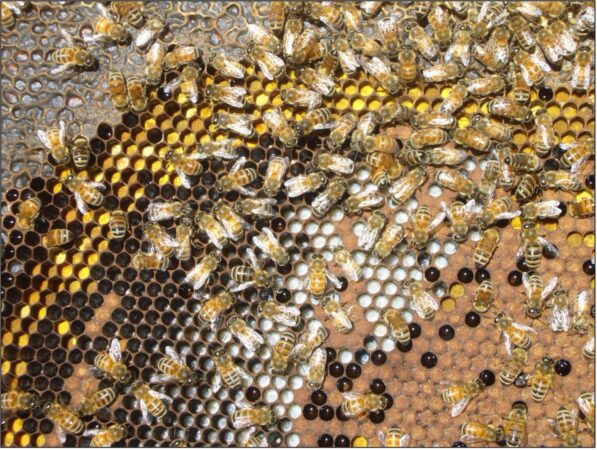
Fig 2. A textbook example of how honey, beebread, and brood are arranged on a comb. But no bee has ever seen this view (it’s dark inside the hive). And just because we commonly see beebread in an arc around the brood, that doesn’t mean that that’s the pollen the nurses pay attention to.
The location of the band of beebread is a perfect example of “survivorship bias,” leading to the erroneous conclusion that pollen foragers preferentially store incoming pollen there. In reality, that band of beebread represents the leftovers — surplus pollen that was not immediately consumed by the nurses. In a well-nourished, rapidly-growing colony on a moderate pollen flow, there may not be any beebread showing around the brood at all.
Practical application: In this case it’s not what we humans see that’s important to the nurses, it’s what we don’t see. In Figure 2 notice the pollen scattered between the cells containing eggs or sealed brood. That’s the pollen that will be first consumed by the nurses. Any pollen in the “pollen band” is surplus beyond the needs of the nurses, and is fermented into beebread for storage.
The classic example of survivorship bias occurred during World War II, when the Air Force recorded the locations of bullet holes in the bottoms of returned aircraft (Figure 3).
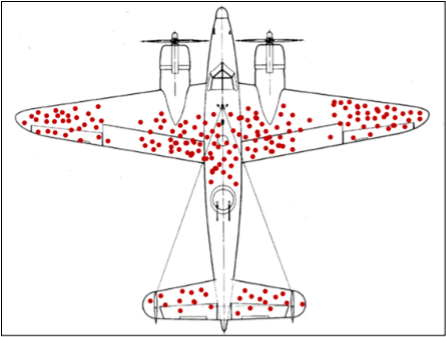
Fig. 3 Mechanic’s notations of where bullet holes were found in planes after bombing missions over Germany. The brass interpreted that to mean that those were the areas calling for reinforcement. But mathematician Abraham Wald pointed out the error of survivor bias, since they were only recording the presence of bullet holes in planes that made it home (the survivors). The important places to armor were the areas lacking bullet holes. Image from Wikipedia.
It’s the same thing with the pollen band on a brood frame. A rapidly-growing colony may not contain any pollen band at all if the nurses are consuming every bit of incoming pollen. The only thing that a pollen band indicates is that there is a temporary surplus of pollen in the hive, left over after the nurses have already consumed their fill.
THE CUE TO THE NURSES THAT A POLLEN FLOW IS OCCURRING
There are several very interesting studies on the interaction between where incoming pollen foragers place their loads, and where nurse bees look for pollen to consume.
In 1969, Doull found that the effective olfactory range of the nurse bees was less than 2 inches [[6]]. And then in 1974 [[7]], using an elegantly simple experimental design, he demonstrated the profound effect of distance from brood for nurse bee response to offered patty of natural pollen (Figure 4).
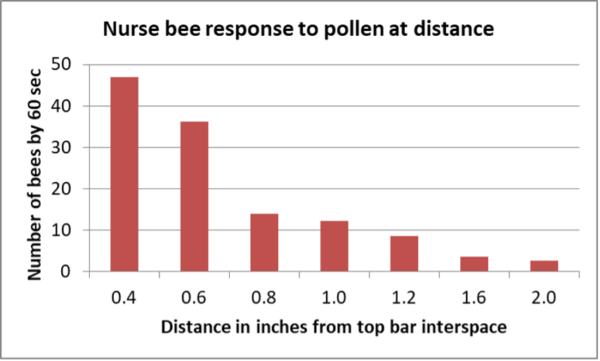
Fig. 4 Note how the response of nurse bees to placed pollen rapidly drops off at even very short distance. (Graph plotted from data from Doull).
Wow! Even two inches of distance makes a huge difference to the nurses, who need to find pollen in the darkness of the hive by their sense of smell.
Doull suggested:
These findings have some implications in the use of pollen for feeding to bees in the hive. Pollen stored around the brood would normally be within the critical distance, or would be located by bees after only a short period of random movement. Pollen stored in outer combs of the hive, however, would be accessible only to those bees that moved away from the brood area. It may well be that, in the main, pollen stored in outer combs will be used only when the brood nest expands to combs near it.
During a substantial pollen flow, one can often observe how the foragers place pollen right in the middle of the brood area (Figure 5).
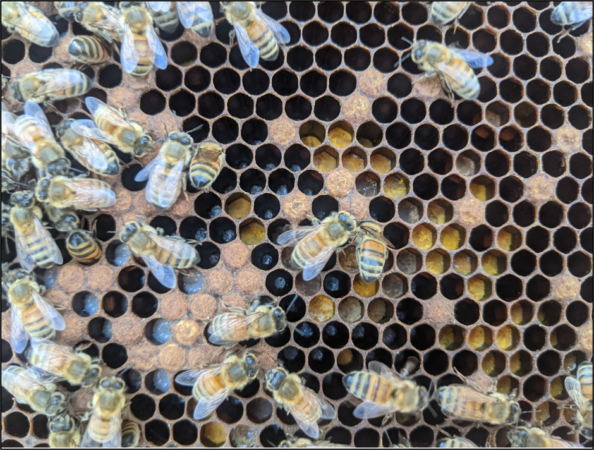
Fig. 5 This pollen placed adjacent to hungry larvae may well disappear overnight, as it is preferentially consumed by the nurse bees. The ease with which the nurses find pollen appears to be the cue that there is a pollen flow going on, indicating that the colony can go into buildup mode.
Note that the pollen in Figure 5 is placed adjacent to older larvae about to be capped. In 1973 Steve Taber [[8]] had things to say about this:
The data indicate that there is a pollen consumption area. As the eggs hatch, the growing larvae are fed more and more. Queens have a tendency to place eggs in adjacent cells if these are available, rather than laying in a random fashion throughout the brood area. As the groups of larvae mature, the consumption of pollen located near larvae aged 5 and 6 days would probably be so rapid that no incoming pollen would or could accumulate in that part of the hive.
My bees are maintained under intensive management for queen and drone rearing and are given more than 40 kg of pollen per colony each year. Therefore, when I hear that bees will not eat the pollen they are offered, I conclude only that the pollen was placed unsuitably in the hive. Unless placed within 4-6 cm of the brood area, the pollen will be taken very slowly or not at all …
The usually accepted hypothesis concerning pollen in combs is that the pollen is stored and consumed in a band around the brood area (Farrar, 1963). My hypothesis is that the belt or band of pollen which surrounds the brood nest during periods of pollen surplus is an area of non-consumption. Since pollen is consumed in the areas of unsealed brood, most new incoming pollen is consumed there. Thus, there is little or no chance of any pollen accumulating inside the brood area.
In 1977 Jerzy Woyke studied brood cannibalism [[9]], noting the higher rate of cannibalism of young larvae in autumn over that in summer.
The higher survival rate of brood when the pollen supply was good, and in colonies to which pollen combs were added … suggests that shortage of pollen releases cannibalism in the honeybees … Pollen may be available in one comb, and not in another, or even in another part of the same comb. So the bees with no pollen nearby, eat brood instead, and are thus able to produce food for the queen and for larvae.
One of my favorite researchers, Scott Camazine, in 1991 rejected the “blueprint hypothesis” and instead laid out a beautiful explanation (self-organizing pattern formation) of how individual bees working in the dark create the textbook arrangement of brood combs, without any bee being aware of a “blueprint” [[10]]:
Each day honey and pollen from tens of thousands of foraging trips are deposited into the cells, stores of honey and pollen cells are continually consumed, hundreds of eggs are laid, mature adult bees emerge from their cells, and diseased brood is removed. Despite the regular turnover in which cells are often refilled with something other than what they recently held, the stability of the pattern is maintained … there is no blueprint to specify locations for brood, pollen and honey; the dynamic relationships among the component processes of deposition and removal are sufficient to organize a pattern on the combs.
Camazine brought up the concept of “interface zones,” which were an aha concept for me for hive inspections and learning to “read the combs” [[11]].
Practical applications:
- Fresh pollen, randomly placed by returning foragers in the cells throughout the broodnest, allows the nurses to produce abundant jelly.
- The ease with which the nurses find fresh pollen next to the brood that they’re feeding cues them to feed, rather than consume young larvae, thus putting the colony into “buildup mode.”
- The presence of a pollen band indicates that there is a surplus of incoming pollen. The inner edge of that band indicates the distance from the brood that the nurse bees needed (or were willing) to travel until they got their fill.
- All the above findings indicate the importance of placing supplemental pollen or artificial diet as close to cells of brood as possible.
- Fresh nectar is also placed throughout the broodnest by mid-age nectar receivers, again providing the nurses with necessary sugar, and the huge amount of water necessary to produce jelly (I’ll discuss this in my next article).
BACK TO MY TRIAL
The colonies in my trial, despite being provided pollen subs ad libitum, generally failed to grow during the late summer and fall. But this is not to say that they weren’t continually rearing brood – just not to enough extent to expand their populations (Figure 6).
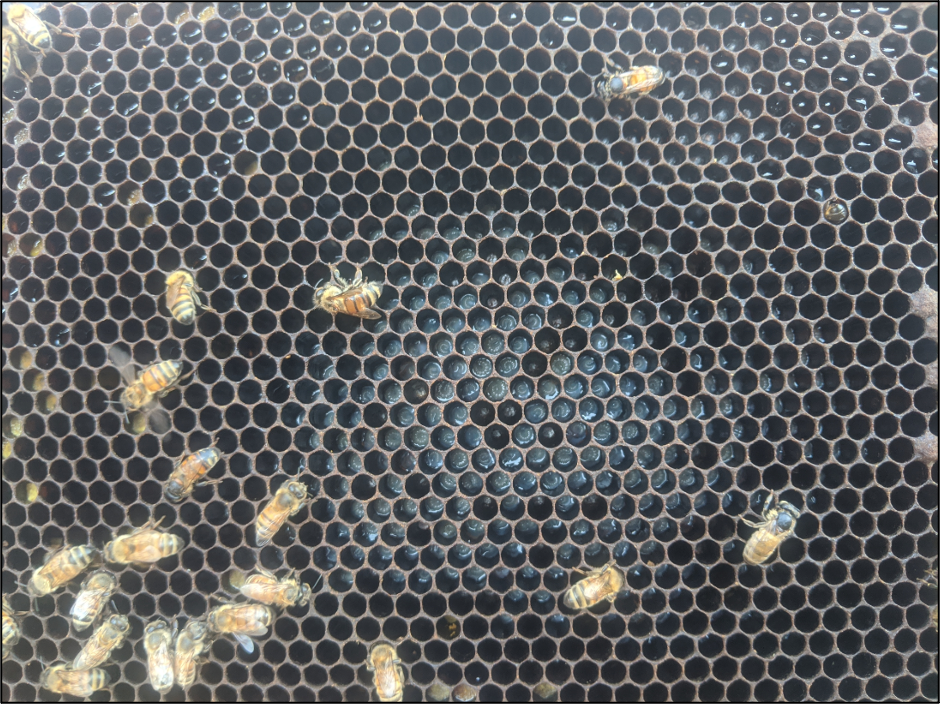
Fig. 6 This photo of a brood comb was taken on 15 October, from a weak colony (3-frame cluster size) that had been completely consuming its pollen sub. As you can see, the larvae were in a good pattern, and well-fed with jelly. But note that although there are only a few cells containing natural pollen on the periphery; there is not a single cell with pollen in the middle of the brood area.
Practical application: So could the benefit of even a minimal pollen flow while feeding pollen sub be due to it being placed by the foragers into the middle of the brood area, even if the beekeeper might not notice it because it is being so rapidly consumed? Could it be that that little bit of pollen right next to the brood provides the cue for the nurse bees to allow for expansion of the broodnest, and then further consume patty offered on the periphery of the brood area? As researchers looking for funding are fond of saying, this clearly calls for more research.
This brings to mind an experiment that I performed in 2010. I fed fluorescent-labeled pollen sub to double-deep hives, placing the patties on the top bars of either the lower or upper brood chamber. After the bees had fed for a couple of days, I froze samples of 50 bees from each comb, crushed their guts out, placed them under UV light, and recorded the percentage that contained fluorescent pigment (Figure 7).
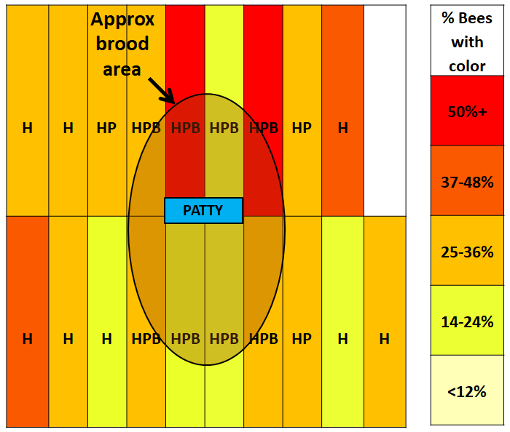
Fig. 7 To my great dismay, a bear ripped the lid off the freezer off before I could process all the samples, but here are two representative results, with the colony fed between the brood chambers to the left, and that fed below the hive cover to the right. H, P, or B indicate honey, pollen, or brood in the comb, respectively. Note that nurse bees that had consumed the labeled pollen sub were present throughout the hive, and that more of them had done so when fed in the middle of the cluster.
Let’s return to my 2020 field trial. It occurred to me that since we had recorded the number of frames of bees (FOB) separately for the lower and upper brood chambers, that I could see whether there was a correlation between the location of the cluster relative to the placement of the pollen sub (since it was always placed on the top bars of the lower brood chamber), and the growth of the colony (indicated by cluster size) (Figure 8).
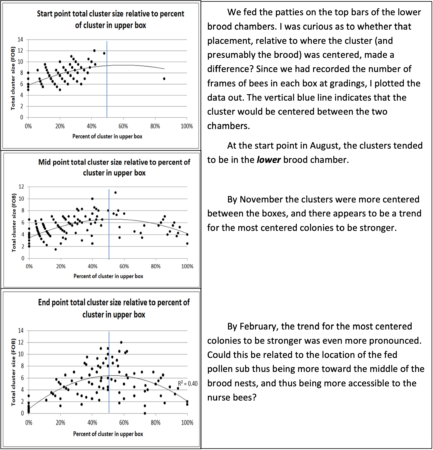
Fig. 8 Let me walk you through this. Colony strength is on the y-axis — the higher the data point, the stronger the colony. Cluster location is on the x-axis — those colonies with the cluster being below the patty being to the left, those with the cluster above the patty to the right, and those with the cluster (and presumably the broodnest) centered on the patty dead center.
Note that over time, the strongest colonies (thus that grew the most) tended to be those in which the cluster was evenly centered above and below the pollen sub patties. This of course is only a correlation, but it sure makes me wonder about the importance of exactly where supplemental protein diet should be offered to the colony. And also whether the reason that soft patty squished between the frames appears to be more stimulatory.
Practical application: Could this be telling us something? In the near-complete absence of a natural pollen flow, perhaps it’s important to place pollen sub closer to the brood. Or maybe provide an additional artificial pollen flow?
BACK TO DRY FEEDING
Perhaps we would have gotten better results if we had concurrently fed a little dry pollen sub for the foragers to place in the brood area. In previous research, I’ve found that bees enthusiastically forage upon offered dry powdered pollen sub offered in the apiary (Figure 9).
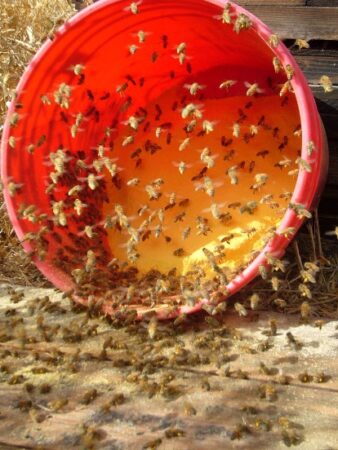
Fig. 9 There are a number of feeders available to keep the powdered sub dry. When I’ve calculated consumption rates, the average per-colony gathering rate of dry sub offered in an apiary feeding station can be equivalent to feeding a 1-lb. patty per week to each hive.
And when I offered foragers fluorescent-labeled dry sub for a single hour, and then inspected combs of brood, it was clear that the returning foragers packed their corbicular loads of dry pollen sub directly adjacent to cells of larvae (Figure 10).

Fig. 10 Under black light, it’s easy to see the bluish-white larvae, and the green fluorescent pollen sub stored after a single hour of offering it in the apiary. This photo confirms Camazine’s observations that pollen foragers randomly place their loads throughout the broodnest.
I hope to experiment further with dry-fed sub concurrent with patty-fed. Dry fed can certainly stimulate jelly production, but I found that it was less consistent colony-to-colony than patty fed. Not only that, but some commercial beekeepers report unfavorable results with dry-fed sub in the fall, supported by an experiment that I ran with some USDA researchers [[12]].
Practical application: I suspect that we still have much to learn about the optimal way to feed artificial diets to colonies. There is of course the tradeoff between practicality and labor costs vs. benefit — it’s difficult to place sub into individual cells in the broodnest in order to stimulate the nurses. Perhaps patties in combination with dry-fed might do the trick. Or some other solution — please let me know if you come up with one!
COMING NEXT
In any case, there is yet one more factor possibly involved in why our colonies grew so poorly during the trial. Next month I’ll look into the importance of nectar, moisture, and humidity as limiting factors for expanding the broodnest.
REFERENCES
[1] https://scientificbeekeeping.com/when-to-feed-pollen-sub/
[2] Lamontagne-Drolet, M, et al. (2019) The impacts of two protein supplements on commercial honey bee (Apis mellifera L.) colonies. Journal of Apicultural Research 58(5): 800-813.
[3] Mattila, H & G Otis (2007) Dwindling pollen resources trigger the transition to broodless populations of long-lived honeybees each autumn. Ecological Entomology 32: 496–505.
[4] Mattila, HR & GW Otis (2006) Influence of pollen diet in spring on development of honey bee (Hymenoptera: apidae) colonies. J. Econ. Entomol. 99: 604-613.
[5] Connor, L (2008) Bee Sex Essentials. Wicwas Press (p. 40).
[6] Keith M. Doull & L. N. Standifer (1969) A technique for measuring feeding responses of honeybees in their hive. Journal of Apicultural Research 8(3): 153-157.
[7] DOULL, K M (1974) Effect of distance on the attraction of pollen to honeybees in the hive. Journal of Apicultural Research 13(1): 27–23.
[8] Taber, S (1973) Influence of pollen location in the hive on its utilization by the honeybee colony. J. Apic. Res. 12(1): 17-20.
[9] J. Woyke (1977) Cannibalism and brood-rearing efficiency in the honeybee. Journal of Apicultural Research 16(2): 84-94.
[10] Camazine, S (1991) Self-organizing pattern formation on the combs of honey bee colonies. Behav Ecol Sociobiol 28:61-76.
[11] https://scientificbeekeeping.com/first-year-care-for-your-nuc/ (search for the word “interface”).
[12] Maes, P, et al. (2016) Diet-related gut bacterial dysbiosis correlates with impaired development, increased mortality and Nosema disease in the honeybee (Apis mellifera). Molecular Ecology 25(21): 5439-5450.



